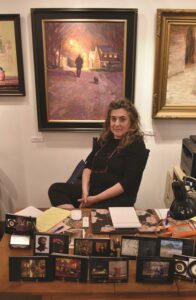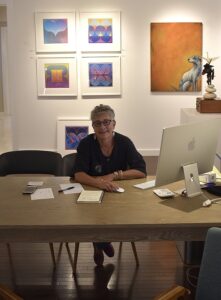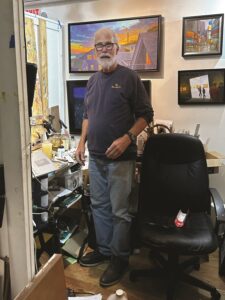Although most art galleries in Provincetown will stay open through December, this Friday, Oct. 6, marks the last official gallery stroll of the season. The Independent asked a few gallery owners to reflect on the summer. For some, it was the best season ever, while for others, sales were off.
Simie Maryles Gallery (435 Commercial St.)

On a misty Thursday night at the end of September most of the galleries are closed, but just past the Mews there’s a light on in the doorway of Simie Maryles’s gallery. She’s inside showing two collectors around.
“We had a great season,” she says. “We were open until 10 or 11 every night. After people have dinner and they want to stroll around, the town should be open. It feels very suburban to close at five o’clock.”
Standing next to a painting of a duck, Maryles tells the reason for her longer-than-average business hours. “It’s for the sake of the artists,” she says. “I don’t have anyone with a trust fund in this gallery. They all need to work.”
Reynolds Gallery (174 Commercial St.)
“I’m just closing the gallery,” says Peg Reynolds, owner of Reynolds Gallery. “It definitely was the worst season I ever had.”
Herra Navassardian, who works as a gallery associate at Reynolds, is known for wearing her fashionable outfits around town. “It has been slow and difficult for us,” she says. “Peg knows at the end of the day it’s not the same, and it’s sad.”
On Center Gallery (352 Commercial St.)

Mary Ashley, a gallery associate at On Center Gallery, says they had a good season but not as booming as the seasons during the pandemic.
“During Covid, people were home looking at their walls,” she says. “They had money to spend because they weren’t going out to dinner or traveling or seeing shows.”
Still, there were highlights this season. On Center’s show of works by Ryan McMenamy sold out. Using gouache and pencil on wood panel, he paints modernist portraits of his friends. “There’s a long list of people who want his work,” Ashley says. “It was an amazing show.”
Woodman/Shimko Gallery (346 Commercial St.)
“It was my slowest season since I opened up 11 years ago,” says Woody Shimko, owner of the gallery. Shimko says he started carrying some gift items in the gallery to make up for the loss of art sales.
Despite an overall downtick, Shimko had success representing the work of Jeff Osmond, who paints his Provincetown Monument series on the stoop outside the gallery. Every single monument painting, done in a loose, flashy, almost abstract style, sold.
Osmond plans to focus on his realist work, very exact still lifes of paintbrushes, jars, and other items around his home, during the off-season. “When you’re painting one series, you’re thinking about the next one,” he says.
Osmond currently paints from a makeshift studio he has set up in his bedroom, but he’s applied for a subsidized studio space at the Provincetown Commons. “We’ll see,” he says. “Maybe I won’t have to use a bedroom anymore.”
Cortile Gallery (230 Commercial St.)

Painter Rob Longley is represented by the Cortile Gallery. He has been painting in Provincetown since 1971, when he came to study art with Henry Hensche.
Sitting in front of a sprawling oil painting of downtown Provincetown at sunset, he says that sales of his work have been down, but that shifting sales cycles are par for the course.
“Everybody has fluctuations in their seasons, and everyone has different years,” he says. “Some people say, ‘It’s a bad year’ every year — but they’re doing fine. I’ve talked to gallery owners, and none of them has any particular explanation for a good year or bad year. I’ve been here years when the stock market wasn’t doing well, and people were spending money, which led me to surmise that the people spending money on art above a certain price point may not care about the fluctuations of the stock market.”
Provincetown Commons (46 Bradford St.)
Rather than pondering the past season, Dave LaFrance, director of operations at the Provincetown Commons, is already populating next year’s calendar. He has events planned from April through December 2024.
The Commons displays the work of local artists who are on the path to gallery representation. “Our audience is loyal and supportive,” LaFrance says. “Most of these artists are showing for the first time. It’s showcased in the pricing. Things are accessible here.”
He says that the Commons tries to help artists as much as possible but will never be able to provide them with what a gallery system can do. “The hardest part of my job,” says LaFrance, “is that our artists work all year getting ready to show, and some people have major success, while some people whose work is just as good and has just as many eyes on it don’t have as much financial success.”
Editor’s note: Because of an editing error, an earlier version of this article, published in print on Oct. 5, incorrectly named the owner of the Woodman/Shimko Gallery. He is Woody, not “Woodman,” Shimko.



